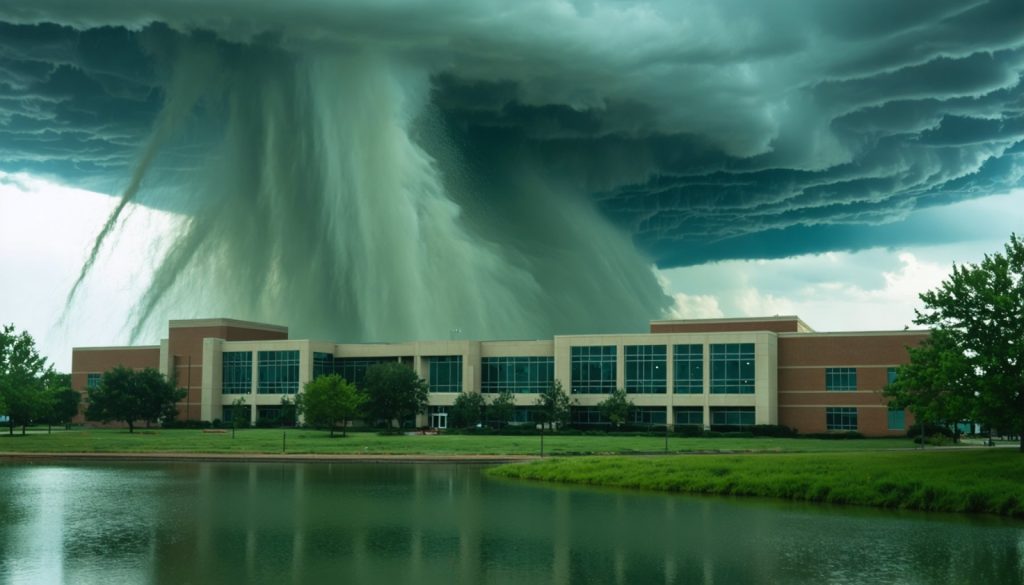
- A “Particularly Dangerous Situation” Flood Watch has been issued for Arkansas Tech University campuses in Russellville and Ozark.
- The community is urged to prioritize safety, with storm shelters available at Hull Building gymnasiums and McEver Hall pit classrooms.
- Emergency manager Heath Whorton emphasizes the hidden dangers of moving water, urging avoidance of flooded roads.
- The ATU community is encouraged to stay informed through reliable sources as severe weather approaches.
- The situation underscores the importance of preparedness, respect for natural forces, and community cohesion.
As ominous clouds gather over Arkansas, a foreboding weather alert looms for the campuses of Arkansas Tech University in Russellville and Ozark. The National Weather Service has signaled a “Particularly Dangerous Situation” Flood Watch, a stern declaration that sends chills through the sprawling university halls. The prospect of severe weather, including a menacing potential for tornadoes, has galvanized the community into action, ensuring that safety becomes the campus’s collective heartbeat.
The vigilant personnel from the Department of Public Safety and Residence Life at ATU are on high alert, their efforts unified to transform the Russellville campus into a bastion of refuge and preparation. Their meticulous strategy unfolds as a call to action: storm shelters will be available within Hull Building gymnasiums and McEver Hall pit classrooms, ready to embrace students and staff seeking shelter from the tempest’s potential fury.
Within the campus, an urgent message rings out—heed the watery threat. The voice of Heath Whorton, ATU’s emergency manager, resonates with an imperative warning, painting a vivid picture of peril: a mere few inches of moving water is a silent force, strong enough to seize a vehicle and transform it into a helpless drift. The message is stark and clear: avoid flooded roadways, where catastrophe lurks beneath the seemingly innocuous flow.
The ATU community is implored to remain vigilant, continuously tuned to trustworthy information sources. As the hours tick toward the potential severe weather window, the necessity for awareness and readiness becomes paramount. The Arkansas Tech University stands as a microcosm of caution and preparedness, a testament to the resilience and foresight of its community.
In navigating these stormy threats, the key takeaway resonates beyond the impending deluge. Preparedness, respect for nature’s might, and community solidarity are not mere precautions—they are essential imperatives. In this dance with danger, vigilance is our strongest ally, urging each member to remain grounded in safety, even amidst the swirling uncertainties of the forecast.
Stay Safe: Protecting Yourself During Severe Weather Events
When severe weather conditions are on the horizon, like the “Particularly Dangerous Situation” Flood Watch issued for Arkansas Tech University, it’s crucial to arm yourself with knowledge and take proactive steps to ensure your safety. Below are additional insights, practical tips, and further considerations to help you navigate such threats effectively.
Key Insights and Safety Measures
Understanding the Threat
1. Flooding: Flooding can occur rapidly and unexpectedly. It is essential to understand the risks associated with both flash floods and slower-rising river floods. According to the National Weather Service, a swift six inches of water can knock over an adult, and just twelve inches of fast-moving water can carry away most vehicles.
2. Tornadoes: Often accompanying severe storms, tornadoes can be unpredictable and devastating. Familiarize yourself with warning signs, such as dark greenish skies, large hail, a loud roar akin to a freight train, or an approaching cloud of debris.
Preparatory Steps
– Awareness: Stay informed via reliable sources such as the National Weather Service or local news stations. Enable weather alerts on your mobile device to receive timely warnings.
– Shelter Locations: Know the designated storm shelters on your campus or community. For ATU, options include the Hull Building gymnasiums and McEver Hall pit classrooms.
– Emergency Kit: Assemble an emergency kit comprising essentials such as water, non-perishable food, medications, flashlight, batteries, first aid supplies, and important documents.
Real-World Use Case: Community Preparedness
Many universities have thorough emergency preparedness plans. These plans include communication strategies, student safety protocols, and regular drills. For instance, the University of Oklahoma has a similar approach to handling tornado threats with mandatory drills and well-communicated emergency procedures.
Additional Considerations
Security and Sustainability
– Ensure emergency plans account for sustainability, minimizing environmental impact during evacuations and shelters.
– Engage in community training about emergency management to bolster collective readiness and responsiveness.
Controversies and Limitations
– Critics highlight that while emergency plans are in place, the real challenge lies in personal accountability—ensuring everyone takes the proper steps without complacency.
Pros & Cons Overview
– Pros: Enhanced safety measures, community solidarity, and preparedness increase overall safety and resilience.
– Cons: Potential for panic if communication is not managed well; resource constraints can limit the efficiency of emergency responses.
Actionable Recommendations
– Avoid Flooded Areas: Do not walk, swim, or drive through floodwaters. If you encounter a flooded roadway while driving, turn around and seek an alternative route.
– Personal Plan: Develop a personal emergency response plan, designating meeting points and communication strategies with family and friends.
– Engage and Educate: Participate in or organize workshops on emergency preparedness in your community or university.
Helpful Links:
– National Weather Service
– Ready.gov (for comprehensive preparedness tips)
In conclusion, severe weather events necessitate vigilance and preparedness. By arming yourself with the right information and taking deliberate preventive actions, you can ensure your safety and that of your community. Stay informed, stay prepared, and prioritize safety above all.



